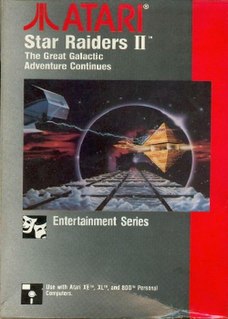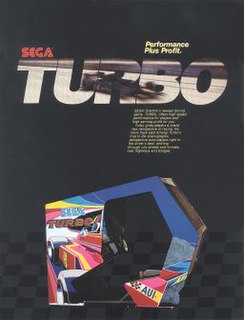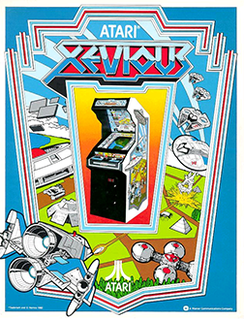 W
WAdvanced Dungeons & Dragons: Treasure of Tarmin is a video game for the Intellivision video game console and the Mattel Aquarius computer system. This game was a licensed Dungeons & Dragons adaptation.
 W
WAnteater is an arcade video game designed by Chris Oberth and released in 1982 by Tago Electronics. The player steers the tongue of the eponymous creature through a maze, retracting it when dangers approach. Though the arcade game was not a hit, it spawned a number of direct clones for home computers; Sierra’s Oils Well became better known than the original. Oberth wrote an Apple II version of his own game for Datamost using a different title.
 W
WCosmic Avenger is a horizontally scrolling shooter developed by Universal Entertainment Corporation and released in arcades by Universal in July 1981. It is one of the first shooters with forced X-axis scrolling along with Konami's Scramble released earlier in the year. The final installment in Universal's Cosmic series, players take control of the Avenger space fighter and use bullets and bombs to fight enemy forces.
 W
WCrack'ed, subtitled "An Egg-Citing Adventure," is a target shooting video game developed by Robert Craig for the Atari ST and released by Atari Corporation in 1988. An Atari 7800 port was published the same year. In Crack'ed the player must protect bird eggs by shooting predators.
 W
WThe Dukes of Hazzard is a 1984 racing video game developed and published by Coleco for their ColecoVision game console and Coleco Adam computer. Elite Systems released a different game with the same title for the ZX Spectrum computer on February 23, 1985. Both versions are based on the television series of the same name.
 W
WElevator Action is a platform-shooter game released in arcades by Taito in 1983. The player assumes the role of Agent 17, a spy infiltrating a 30 story building filled with elevators and enemy agents who emerge from closed doors. The goal is to collect secret documents from specially marked rooms, then escape the building. It runs on the Taito SJ System arcade system.
 W
WFood Fight is an arcade game developed by General Computer Corporation and released by Atari, Inc. in March 1983. The player guides Charley Chuck, who is trying to eat an ice cream cone before it melts, while avoiding four chefs bent on stopping him. 1,951 arcade cabinets were sold.
 W
WI, Robot is an arcade shooter game developed and released in 1984 by Atari, Inc. Designed by Dave Theurer, only a total of 750–1000 arcade cabinets were produced. The arcade machine comes with two games. The first is I, Robot, a multi-directional shooter that has the player assume the role of "Unhappy Interface Robot #1984", a servant bot that rebels against Big Brother. The object of the game involves the servant bot going through 126 levels, turning red squares to blue to destroy Big Brother's shield and eye. The player can switch to the second game, Doodle City, a drawing tool that lasts for three minutes.
 W
WKick is an action video game where the player controls a clown on a unicycle catching falling balloons and Pac-Man characters on the clown's hat. It was released in arcades by Midway in 1981. The game was later renamed Kick Man. Commodore published a Commodore 64 port in 1982 without the space in the title as Kickman.
 W
WStar Raiders II is a video game released in 1986 for the Atari 8-bit family as a sequel to 1979's Star Raiders, which was the killer app for the Atari computers. The game was originally developed as part of a tie-in with the movie The Last Starfighter, which featured an arcade game of the same name as part of its plotline. Versions for the Atari 5200 and the Atari 8-bit computers were developed in 1984, although those were never released. Later the tie-in was dropped, and the game converted into a sequel to Star Raiders by changing a number of gameplay elements. The gameplay remained different from the original Star Raiders.
 W
WLooping is a 1982 action arcade video game developed and published by Video Games GmbH in Europe and Venture Line in North America. In the game, players control a plane across two phases in order to reach a docking station by destroying a terminal base or a rocket base to open a gate while avoiding obstacles along the way. Its gameplay mainly consists of action using a two-button configuration.
 W
WSwordquest is an unfinished series of video games produced by Atari, Inc. in the 1980s as part of a contest, consisting of three finished games, Earthworld, Fireworld, and Waterworld, and a planned fourth game, Airworld. Each of the games came with a comic book that explained the plot, as well as containing part of the solution to a major puzzle that had to be solved to win the contest, with a series of prizes on offer whose total value was $150,000. The series had its genesis as a possible sequel to Atari's groundbreaking 1979 title Adventure, but it developed mythology and system of play that was unique.
 W
WTempest is a 1981 arcade game by Atari Inc., designed and programmed by Dave Theurer. It takes place on a three-dimensional surface divided into lanes, sometimes as a closed tube, and viewed from one end. The player controls a claw-shaped "blaster" that sits on the edge of the surface, snapping from segment to segment as a rotary knob is turned.
 W
WTurbo is an arcade racing game released in 1981 by Sega. Designed and coded by Steve Hanawa, the game received positive reviews upon release, with praise for its challenging and realistic gameplay for its time, three-dimensional full-color graphics with changing scenery, and cockpit sit-down arcade cabinet replicating a race car. It became a commercial success, topping the monthly Play Meter arcade charts in North America and ranking highly on the Game Machine arcade charts in Japan.
 W
WXevious is a vertically scrolling shooter developed by Namco and released in arcades in 1982. It was published in Japan and Europe by Namco and in North America by Atari, Inc. Controlling the Solvalou starship, the player attacks Xevious forces before they destroy all of mankind. The Solvalou has two weapons at its disposal: a zapper to destroy flying craft, and a blaster to bomb ground installations and enemies. It runs on the Namco Galaga arcade system.